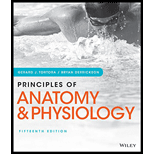
Concept explainers
Define a tissue.
To review:
Definition of biological terminology, “tissue.”
Introduction:
The tissue is an organizational level consisting of group of structurally and functionally identical cells that perform a specific function.
Explanation of Solution
Some factors affect the structure and properties of a specific tissue. Extracellular material that surrounds the cell and the underlying connections between the cells of the tissue affect the properties of tissues. The different types of tissues are found in different parts of the body.
These tissues are organized into four broad categories:
Epithelial: Covers exterior surfaces of the body.
Connective: Binds the cells and organs of the body. Provides protection, support, and integration to all body parts.
Muscle: Responds to stimulus and contracts for movement. Three types of muscle tissues are found: skeletal, smooth, and cardiac muscle tissues.
Nervous: Propagates electrochemical signals in the form of nerve impulses to different parts of the body.
The tissues are found in all multicellular organisms; however, they are absent in unicellular organisms.
Want to see more full solutions like this?
Chapter 4 Solutions
Principles of Anatomy and Physiology
Additional Science Textbook Solutions
Laboratory Experiments in Microbiology (12th Edition) (What's New in Microbiology)
Chemistry: An Introduction to General, Organic, and Biological Chemistry (13th Edition)
Microbiology: An Introduction
Campbell Essential Biology (7th Edition)
Campbell Biology in Focus (2nd Edition)
Microbiology: An Introduction
- Not part of a graded assignment, from a past midtermarrow_forwardNoggin mutation: The mouse, one of the phenotypic consequences of Noggin mutationis mispatterning of the spinal cord, in the posterior region of the mouse embryo, suchthat in the hindlimb region the more ventral fates are lost, and the dorsal Pax3 domain isexpanded. (this experiment is not in the lectures).a. Hypothesis for why: What would be your hypothesis for why the ventral fatesare lost and dorsal fates expanded? Include in your answer the words notochord,BMP, SHH and either (or both of) surface ectoderm or lateral plate mesodermarrow_forwardNot part of a graded assignment, from a past midtermarrow_forward
- Explain in a flowcharts organazing the words down below: genetics Chromosomes Inheritance DNA & Genes Mutations Proteinsarrow_forwardplease helparrow_forwardWhat does the heavy dark line along collecting duct tell us about water reabsorption in this individual at this time? What does the heavy dark line along collecting duct tell us about ADH secretion in this individual at this time?arrow_forward
 Human Physiology: From Cells to Systems (MindTap ...BiologyISBN:9781285866932Author:Lauralee SherwoodPublisher:Cengage Learning
Human Physiology: From Cells to Systems (MindTap ...BiologyISBN:9781285866932Author:Lauralee SherwoodPublisher:Cengage Learning Human Biology (MindTap Course List)BiologyISBN:9781305112100Author:Cecie Starr, Beverly McMillanPublisher:Cengage Learning
Human Biology (MindTap Course List)BiologyISBN:9781305112100Author:Cecie Starr, Beverly McMillanPublisher:Cengage Learning
 Biology: The Unity and Diversity of Life (MindTap...BiologyISBN:9781305073951Author:Cecie Starr, Ralph Taggart, Christine Evers, Lisa StarrPublisher:Cengage Learning
Biology: The Unity and Diversity of Life (MindTap...BiologyISBN:9781305073951Author:Cecie Starr, Ralph Taggart, Christine Evers, Lisa StarrPublisher:Cengage Learning





